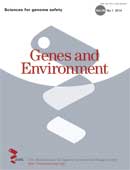Although nucleotide excision repair (NER) removes bulky adducts upon exposure to various chemicals, base excision repair (BER) removes altered bases that cause relatively minor disturbances to the helical DNA structure. We have shown that the action of BER can be distinguished from that of NER by the enhancement of a comet-positive response by 2′,3′-dideoxythymidine (ddT). Furthermore, in this study, the action of NER is shown to be distinguishable from that of BER by the reduction of a comet-positive response by α-amanitin (AMN). To study how bulky alkylated bases can be removed by NER or BER, we studied the reduction of a comet-positive response by AMN and its enhancement by ddT for
n-alkyl methanesulfonates having an
n-alkyl group with 1-7 carbons. For this purpose,
n-alkyl methanesulfonates having an
n-alkyl group with 3-7 carbons (
n-propyl methanesulfonate,
n-butyl methanesulfonate,
n-pentyl methanesulfonate,
n-hexyl methanesulfonate, and heptyl methanesulfonate) were synthesized. AMN reduced the comet-positive response for
n-alkyl methanesulfonates having an
n-alkyl group with ≧4 carbons and ddT enhanced it for
n-alkyl methanesulfonates having an
n-alkyl group with ≦5 carbons. Therefore, it is considered that NER acts to remove bases alkylated by
n-alkyl groups with ≧4 carbons, BER acts to remove bases alkylated by
n-alkyl groups with ≦5 carbons, and both NER and BER act to remove bases alkylated by
n-alkyl groups with 4 and 5 carbons.
抄録全体を表示
